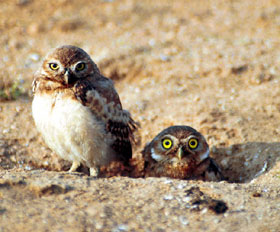Burrowing Owls
Air Date: Week of September 24, 2004
Living on Earth’s Jennifer Chu reports on an unusual tool that some owls use to trap their dung beetle dinner.
Transcript
CURWOOD: Just ahead: Flying the friendly skies for the environment. First, this Note on Emerging Science from Jennifer Chu.
[SCIENCE NOTE THEME]
CHU: In the grasslands and deserts of some southwestern states, you might come across a small scavenging owl. It’s been described by some as a short fat bird on stilts – whose common name is the Burrowing Owl. That’s because it makes its home not in the trees, but in the ground.
 A pair of Burrowing Owls (Athene cunicularia) (Photo: Stephen Pitt)
A pair of Burrowing Owls (Athene cunicularia) (Photo: Stephen Pitt)
To test this theory, researchers removed the animal waste from a group of owl dens. They then replaced some of the dens with fresh droppings, and left the others empty. After four days, they measured the amount of beetle carcasses around the dens, and found the owls with droppings outside their burrows ate ten times more than those without. Scientists suggest that these owls evolved to use animal droppings as a trapping tool, a strategy they’ve dubbed “bait and wait.”
That’s this week’s Note on Emerging Science, I’m Jennifer Chu.
CURWOOD: And you’re listening to NPR’s Living on Earth.
ANNOUNCER: Support for NPR comes from NPR stations, and: The Noyce Foundation, dedicated to improving math and science instruction from kindergarten through grade 12; Ford, presenting the Escape Hybrid, whose full hybrid technology allows it to run on gas or electric power. Full hybrid technology details at fordvehicles dot com; The Annenberg Fund for excellence in communications and education; and, The Kellogg Foundation, helping people help themselves by investing in individuals, their families and their communities. On the web at w-k-k-f dot org. This is NPR -- National Public Radio.
[MUSIC: Medeski Martin and Wood “New Planet” END OF THE WORLD PARTY (JUST IN CASE) (Blue Note – 2004)]
Living on Earth wants to hear from you!
Living on Earth
62 Calef Highway, Suite 212
Lee, NH 03861
Telephone: 617-287-4121
E-mail: comments@loe.org
Newsletter [Click here]
Donate to Living on Earth!
Living on Earth is an independent media program and relies entirely on contributions from listeners and institutions supporting public service. Please donate now to preserve an independent environmental voice.
NewsletterLiving on Earth offers a weekly delivery of the show's rundown to your mailbox. Sign up for our newsletter today!
 Sailors For The Sea: Be the change you want to sea.
Sailors For The Sea: Be the change you want to sea.
 The Grantham Foundation for the Protection of the Environment: Committed to protecting and improving the health of the global environment.
The Grantham Foundation for the Protection of the Environment: Committed to protecting and improving the health of the global environment.
 Contribute to Living on Earth and receive, as our gift to you, an archival print of one of Mark Seth Lender's extraordinary wildlife photographs. Follow the link to see Mark's current collection of photographs.
Contribute to Living on Earth and receive, as our gift to you, an archival print of one of Mark Seth Lender's extraordinary wildlife photographs. Follow the link to see Mark's current collection of photographs.
 Buy a signed copy of Mark Seth Lender's book Smeagull the Seagull & support Living on Earth
Buy a signed copy of Mark Seth Lender's book Smeagull the Seagull & support Living on Earth

